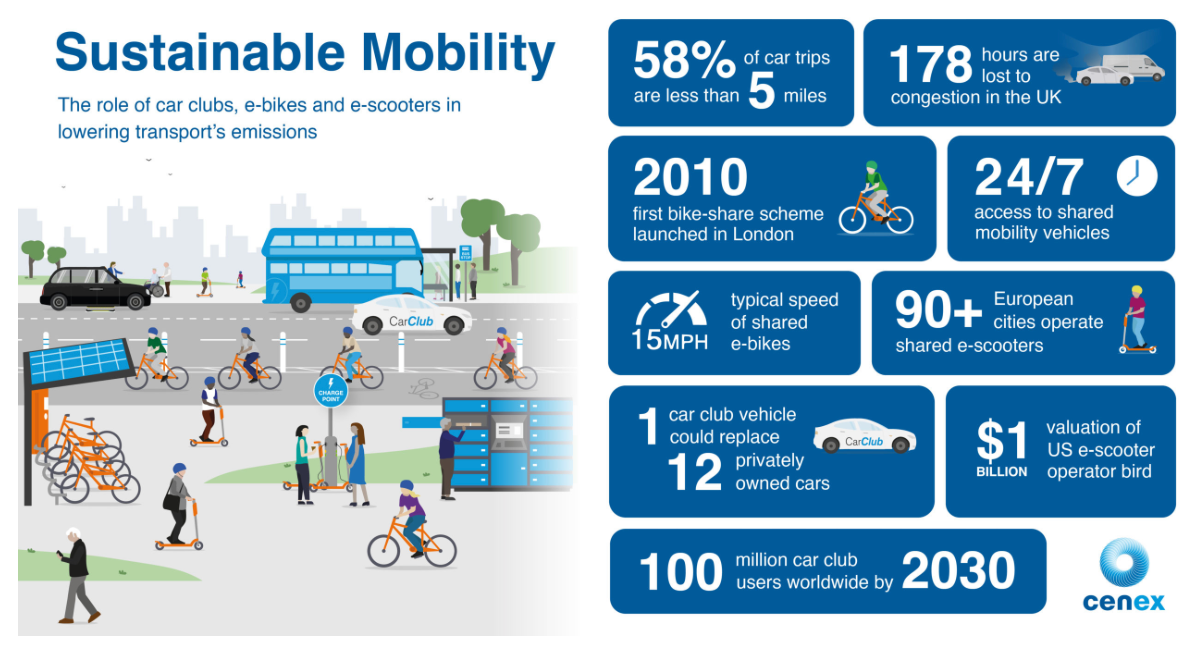The future of mobility in transportation is more than just getting from one place to another. Businesses and government leaders at every level are focusing on enabling people to move more efficiently and sustainably.
City managers are rethinking how people travel, how transit systems are built, and how public services can adapt to growing environmental pressures.
Transport modes contribute to a huge percentage of global CO2 emissions. Investing in sustainable infrastructure for cities will lead to greener, more connected urban environments.
What we will cover:
- Understanding the Link Between Mobility and Sustainability
- The Pillars of Sustainable Transportation
- How Shared Mobility Supports a Greener Future
- The Role of Technology in Sustainable Mobility
- Benefits for Cities, Businesses, and the Planet
- The Challenges to Achieving Sustainable Mobility
So, here's what you need to know.
Understanding the Link Between Mobility and Sustainability
Increasing access to ride services, buses, and other mobility solutions will help cities reach their sustainability goals.
Even investments in walking paths and shared-use areas contribute to a greener urban environment. Here’s a closer look at the link between mobility and sustainability.
What Sustainable Mobility Really Means
Sustainable mobility refers to transportation systems that meet present travel needs without compromising the needs of future generations.
These solutions prioritize accessibility and equity while improving the overall quality of life of residents.
This means designing services that reduce dependency on single-occupancy vehicles and promote shared, efficient travel.
The Environmental Impact of Traditional Transport Systems
Traditional mobility models are dominated by private car use and fossil fuel consumption.
While these models provide users with a strong sense of autonomy, they also drive up congestion and have led to high emissions. These systems strain the infrastructure and hurt the climate.
Why Smarter Mobility Is Key to Net-Zero Goals
Achieving net-zero ambitions on a global scale means rethinking how mobility solutions are planned, operated, and used.
Eco-friendly transportation (such as electric vehicles) is a key part of this transition. However, on-demand transport options and demand-based solutions are also essential to promote user adoption at scale.
Everyone wins when mobility in transportation is used to further sustainability initiatives. Key benefits include:
The Pillars of Sustainable Transportation
A sustainable transportation strategy is built on the following principles:
- Reducing vehicle Emissions
- Promoting Energy Efficiency
- Design Cities Around People
- Use Data to Improve Transportation
Reducing Vehicle Emissions Through Shared Travel
Encouraging carpooling and other shared modes of transit helps minimize the number of vehicles on the road, reducing congestion and carbon output.
Mobility platforms support real-time matching and scheduling that make shared commuting practical for organizations and communities alike.
Promoting Energy Efficiency and Electrification
Electric vehicles and hybrid buses can help cities lower emissions while improving energy efficiency.
To support these vehicles, cities will need to invest in charging infrastructure and intelligent management software.
The goal is to adopt more efficient vehicles while also implementing the infrastructure to use them.
Designing Cities Around People, Not Cars
Currently, cities are built around the personally owned vehicle model.
Walkable cities and protected cycling lanes will encourage urban dwellers to tackle short distances without relying on fossil fuels.
However, retrofitting city centers is a long-term endeavor that must be addressed in stages.
Using Data to Improve Transport Planning
Having access to high-quality data is one of the most important factors for effective demand planning.
Data analytics empowers planners to forecast demand and optimize service routes based on the needs of residents.
How Shared Mobility Supports a Greener Future
Shared mobility in transportation can pave the way for lower emissions and a greener, cleaner future for everyone.
Here are some ways that sharing transportation leads to a better environment:

Cleaner Air and Less Congestion in Urban Areas
When low-emissions services are adopted at scale, it leads to cleaner air and quieter streets. Cutting down on congestion creates a trickle-down effect, meaning commuters can get where they are going faster.
The city’s population also becomes healthier, as reduced traffic enhances livability and boosts public well-being.
Reduced Operating Costs and Better Accessibility
Shared and electric modes of transport cut down on fossil fuel consumption.
Consumers enjoy lower maintenance expenses. Under-served populations will benefit from improved access to transportation, making the entire transit network more inclusive.
Stronger ESG Performance for Organizations
Sustainability has become a core goal for businesses across the globe. Companies that adopt smarter mobility initiatives can enhance ESG metrics and demonstrate their commitment to corporate responsibility.
Building More Liveable, Connected Communities
When infrastructure supports sustainable mobility, communities thrive. Integrated public transit and shared travel options make cities more connected and equitable.
The Challenges to Achieving Sustainable Mobility
Carpooling and Ride Sharing for Low-Carbon Commuting
Carpooling programs reduce emissions by consolidating multiple trips into one vehicle.
For example, let’s say that 100 employees of a business participate in a company-backed carpooling program.
Instead of driving 100 separate vehicles to work each day, the employees ride in pairs. That would slash vehicle traffic by 50% and cut carbon emissions, too.
On-Demand Transport and Demand-Responsive Services
On-demand transportation optimizes routes based on real-time customer needs. Demand-responsive transport minimizes empty rides and reduces wasted energy.
These services must be fine-tuned to meet the needs of early adopters so that shared transportation initiatives don’t lose steam.
Integrating Shared Transport With Public Transit Networks
When shared mobility connects seamlessly with public transport, passengers gain flexibility while cities benefit from fewer private vehicles.
User-friendly mobile apps are essential as they act as the digital gateway to shared mobility services, providing accurate journey information, efficient trip coordination, and a uniform experience that strengthens passenger confidence.
User-friendly mobile apps are essential User-friendly mobile apps are also essential, as they support seamless trip planning and make shared transport easier to navigate.
Corporate Mobility Programs That Cut Emissions at Scale
Businesses are also investing in shared commuting. Shuttle services for staff and company-backed carpooling programs encourage employees to reduce their overall carbon footprint.
The key is to make these programs accessible and convenient.
The Role of Technology in Sustainable Mobility
Transitioning from the largely user-driven transportation model to a shared approach requires sophisticated technologies. The most important tech solutions needed for sustainable mobility include:
AI and Predictive Routing to Reduce Empty Miles
Artificial intelligence enables system optimization through predictive routing, which ensures that vehicles operate efficiently.
The goal is to group passengers in the most intelligent way possible to reduce wasted miles and minimize wait times.
Real-Time Data for Energy-Efficient Operations
Operators can rely on IoT sensors and GPS data to analyze performance and predict demand.
These insights also promote more efficient resource management and less waste. Over time, this data promotes better energy efficiency and seamless operations.
Benefits for Cities, Businesses, and the Planet

Everyone wins when mobility in transportation is used to further sustainability initiatives. Key benefits include:
Cleaner Air and Less Congestion in Urban Areas
When low-emissions services are adopted at scale, it leads to cleaner air and quieter streets. Cutting down on congestion creates a trickle-down effect, meaning commuters can get where they are going faster.
The city’s population also becomes healthier, as reduced traffic enhances livability and boosts public well-being.
Reduced Operating Costs and Better Accessibility
Shared and electric modes of transport cut down on fossil fuel consumption.
Consumers enjoy lower maintenance expenses. Under-served populations will benefit from improved access to transportation, making the entire transit network more inclusive.
Stronger ESG Performance for Organizations
Sustainability has become a core goal for businesses across the globe. Companies that adopt smarter mobility initiatives can enhance ESG metrics and demonstrate their commitment to corporate responsibility.
Building More Liveable, Connected Communities
When infrastructure supports sustainable mobility, communities thrive. Integrated public transit and shared travel options make cities more connected and equitable.
The Challenges to Achieving Sustainable Mobility
Adopting a sustainable mobility model means overcoming the following barriers:
Infrastructure and Policy Limitations
Outdated infrastructure and fragmented regulations can hinder the adoption of sustainable transport models. Therefore, operators must invest in data platforms and infrastructure.
Behavioral Change and User Adoption
Individuals will likely be hesitant to give up the autonomy associated with private transport.
Therefore, operators must educate and provide incentives to help people choose shared or active modes over personal car use.
Balancing Technology Investment and Affordability
Emerging mobility tech can be costly. Ensuring that these resources are affordable and accessible is vital so that adoption is equitable.
How Liftango Drives Sustainable Transportation
Liftango supports sustainable transport options in the following ways:
Data-Driven Insights for Greener Operations
Our platform features powerful analytics tools that enable you to measure, report, and reduce transportation emissions.
Liftango supports efficient scheduling and routing, ensuring that every vehicle is deployed optimally.
Flexible Carpool and On-Demand Platforms for Cities and Campuses
Our smart platforms support on-demand shuttles and carpooling initiatives that improve accessibility and cut emissions.
These adaptable solutions are designed to serve both corporate and public clients. If your organization is ready to help people move smarter, Liftango is the ideal partner.
Supporting Public and Private Partners in Their ESG Goals
Liftango works with municipalities, universities, and enterprises to implement customized sustainable transport solutions.
Our team can align the project with climate commitments or ESG goals.
Learn More About Mobility in Transportation
Liftango is committed to reshaping the way people move, travel, and commute to work. Our forward-thinking solutions for mobility optimization can be tailored to align with your needs.
Ready to take the next step toward smarter mobility? Contact us to learn more.

FAQs
How Does Shared Mobility Reduce Emissions?
When individuals share rides or switch to group transport, it decreases the number of vehicles on the road and cuts down on emissions.
What Role Does Technology Play in Sustainable Transport?
Technology allows operators to optimize routes and meet the transportation demands of consumers, which encourages higher adoption rates.
How Can Organizations Support Sustainable Mobility Initiatives?
Businesses can introduce carpooling programs and shuttles to promote sustainable mobility within their workforce.
%20(1).jpg)